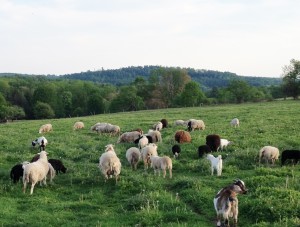It’s a great experience to wake up the sounds of sheep and goats moving through your backyard. Except when they start grazing at four thirty in the morning. Or when the guard geese see an imagined predator and honk loudly for several minutes. Or when a young kid uses your window screen as a scratching post and almost breaks the window in the process. Yes, I’ve learned that raising small pasture animals is not quite the idyllic experience one might expect.
I had a little bit of experience with sheep care going into my internship, thanks to ANSCI 3800. But I learned a lot from solving various problems and getting hands on experience. Quails-R-Us has a mixed breed flock of about thirty ewes and a herd of about ten does. The animals are bred to off the farm rams and bucks once a year, and their offspring are either kept for breeding or sold for meat. The flock has had excellent breeding success despite minimal culling, and nearly every ewe has two lambs a year. The goats usually have one kid a year. Birthing was over by the time I arrived, but it happens in the safety of the barn, using lambing jugs. At night, the sheep and goats seek out the shelter of the barn, and often spend the night inside. Despite often hearing coyotes at night from my room, the farm has minimal predator problems and lambs and kids are more likely to die from becoming tangled in the Electronet. Ideally, the animals would rotate through the 30 acres of pasture of the farm evenly, grazing everything down before being moved to the next paddock, but the permanent electric fencing on the farm hasn’t worked in years so in reality the animals have free run of the entire farm, from pastures to neighbor’s fields to the flowers planted under the kitchen window.

On the pasture
I helped with a variety of tasks related to goat and sheep care, besides taking daily walks around the farm and untangling babies from the fencing. I helped feed the animals in the morning for a few weeks. In the weeks after birthing, Rick and Linda provide a little bit of grain in the morning mixed with vitamins and minerals to keep the animals healthy and to acclimate the babies to humans. One ewe had triplets, and her runt lamb, Mia, was bottlefed several times a day. She is a very persuasive baby, and often chased after you and insisted on feeding even when it wasn’t feeding time. My hilarious video of such encounter was too large to upload, but believe me, she was feisty. One of my first major husbandry tasks was shearing. QRS hires a professional shearer, but he has limited availability, so while usually sheep are sheared before lambing, the QRS sheep were sheared in mid-June. The sound of grain in a bucket brought them running into the barn in the middle of the day. We meticulously separated out the goats, kids, and lambs, which required a lot of patience and quick reflexes. The isolated ewes then were brought out one by one to be sheared and released. Several of the QRS sheep have Katahdin heritage, meaning they partially shed their wool. An abundance of burdock and thistle in the pasture combined with this partially shod wool meant that the wool was nearly worthless, even by meat sheep standards. It wasn’t worth our time to try to dry and sell it, and since wool is naturally fire retardant, we couldn’t burn it, so we left it in the pasture, where birds took fibers for their nests.
Hoof trimming was another fun challenge for me. I’ve trimmed the hooves of sheep before but when faced with a large goat with a hoof problem, I was a bit lost. The goat, named Cow for her black and white markings, was almost as strong as I was and much more insistent about what was going to happen. My first attempts, when I managed to pin her in place and lift her hoof, took off far too little of the excess keratin, and I eventually had to admit defeat and hand over responsibility to Ramone, who wasted no time getting to the heart of the issue and swiftly freed Cow from her painful hooves. I helped disinfect her feet and gave her some grain for her trouble. I’d like to think she eventually forgave me.
Towards the end of the summer, we did take the growing lambs and kids meant for butchery, now weaned, and isolate them in a side pasture with a permanent fence. Corralling animals across several acres of pasture is an adventure, but with a team we got it done. When some animals were large enough to be taken to the butcher, we weighed them first, and placed them on the trailer. And the lamb steaks and goat chorizo we got back were delicious.

